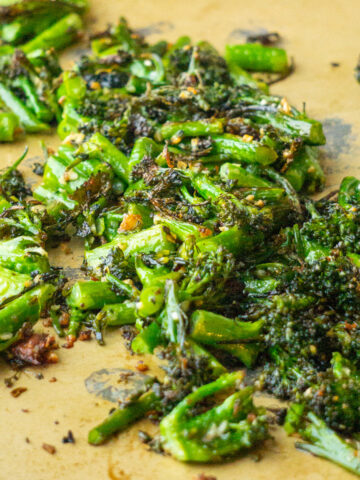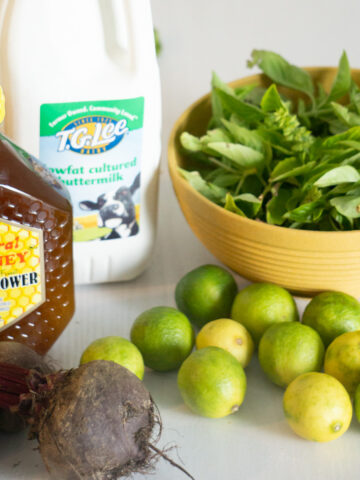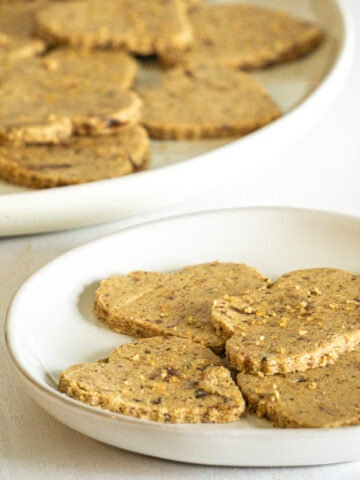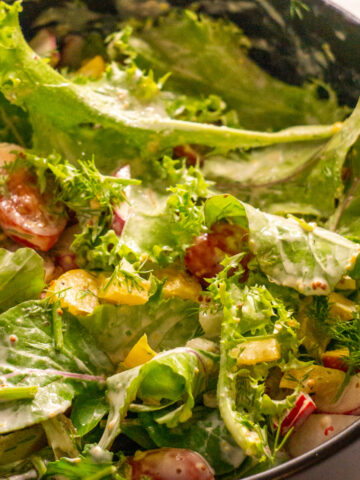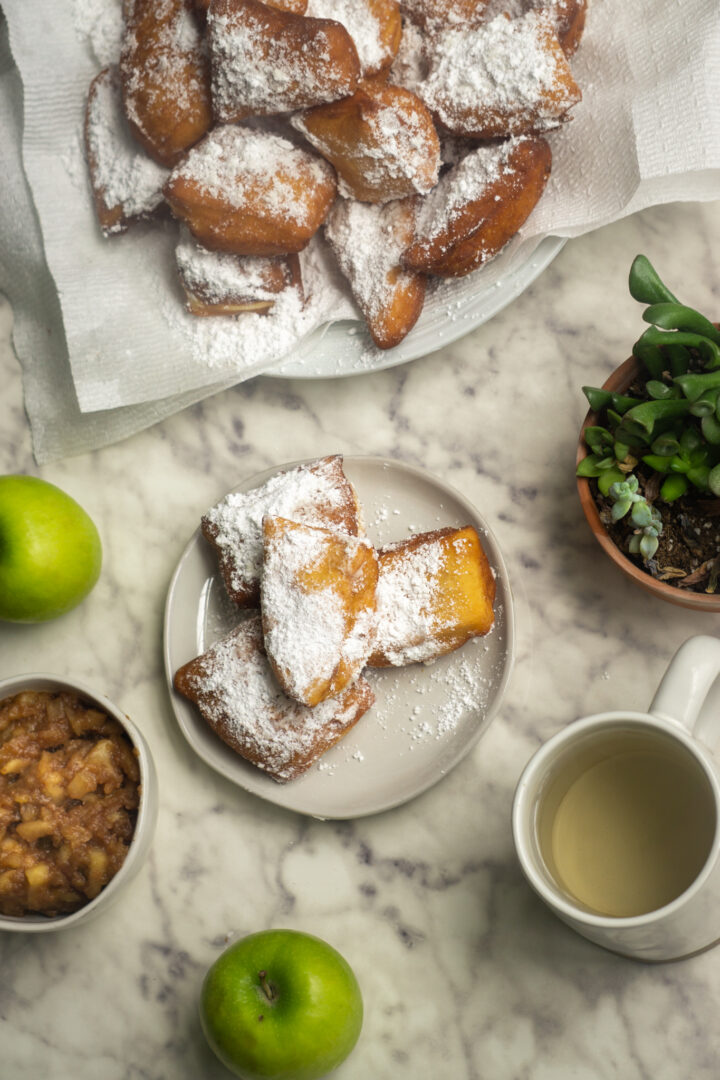
I’ve eaten a lot of great things in my life. I made whole wheat croissants on Christmas morning and ate them piping hot with lemon curd. For birthdays, I’ve made a frangipane pithivier with creamy almond filling, and a Chantilly cake bursting with berries. I’ve even fried pickles for a crowd and toured Mexican restaurants all across the Southwest U.S. on a road trip.
But what is the best food I’ve ever eaten? Beignets. This food.
A brief history of beignets
If you’re not familiar with the French Quarter in New Orleans, you might not know about these soft dough pillows covered head to toe in powdered sugar. But at the famous Café du Monde, they’re traditional fare alongside chicory-flavored café au lait.
The creole treat has roots in French cuisine. “Beignet” is simply the name for “fritter” and describes fried dough balls of many kinds. This rich snack food has a special connection with Mardis Gras and Lent in France.
Did I go down a click-hole of fritters from around the world to make this? Yes. The answer is yes.
In doing so, I discovered that there might be nothing more popular globally than fried dough, especially for various holidays. So here’s a list of fritters from various places around the world. Comment below if there’s one that I’m missing…I’m sure this is just the beginning!
Fritters from around the world
Apple Fritters – This one is from my culture! This dense doughnut smothered in icing is the first thing I think of when I hear the word “fritter.” As a kid, I chose this as my post-church doughnut, mostly for its hulking size.
Loukoumades – Picture this. I just climbed up and down Mount Olympus (yes, it’s a real mountain in Greece) and took a dip in the warm Mediterranean Sea, when I see someone wandering around the pebbly beach selling plastic cups of little yeasted dough balls oozing with honey. Of course I got some! My first bite and I felt like a goddess.
Puff Puff – Yet another yeasted doughnut snack, this time with a bit more sugar in the batter instead of on top. It’s a popular African street food, and this blog comes with many variations.
Buñuelos de Viento (Mexican) – This dessert is a fritter of Spanish origin but has different iterations in different regions. This Mexican version comes in the shape of a beautiful flower and is common around Christmastime.
Buñuelos de Viento (Dominican) – This version is a fried ball of dough in spiced syrup. Traditionally, Dominican buñuelos de viento are eaten around Lent.
Pets de Nonne (Nun’s Farts) – Yes, you read that right. The name of this dessert comes from a farting sister It’s another French fritter variation for Mardi Gras, and like many European fritters, its base dough is pâte à choux, or the non-yeasted dough you use to make a cream puff.
Chichis-Fregis – Alert vegans! This churro-like fritter contains NO animal products! Plus, this French variation on the fritter is made with chickpea flour and even orange blossom water.
Sonhos – Literally translated from Portuguese as “dreams,” sonhos are little fried puffs that are lemon-flavored and rolled in castor sugar a la Dunkin Donuts. Yet another great variation on a theme!
Gulab Jamun – This is an analogous dessert from Punjab/northern India. It features cardamom-spiced syrup, and the balls of dough actually contain khoya, which is basically milk boiled down to a solid consistency. Very. Rich.

How to make beignets
Step 1: First, add one-and-a-half teaspoons yeast and 1 tablespoon sugar to a large bowl filled with ¾ cup warm water and ½ cup warm milk. (“Warm” means bathwater temperature but not too hot). Wait about 10 minutes, or until the yeast is all frothy.
Step 2: Add 1 teaspoon vanilla, 2 tablespoons melted butter, 1 egg, and 3 more tablespoons sugar. Beat with a whisk until homogenized. Keep whisking as you add three-and-a-half cups of flour in three or four bouts, whisking well after each addition. Keep mixing with a spoon until a VERY shaggy, wet, sticky dough forms. It will be something like a biscuit batter.
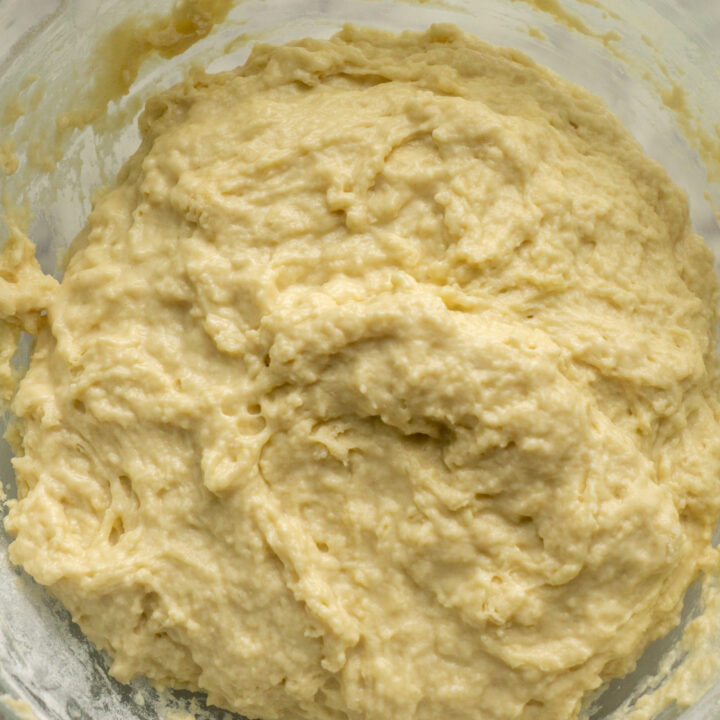
Step 3: Put the dough into a large greased bowl, and roll it around so that the whole thing gets coated in oil. Let the dough sit for three hours, or until it has tripled in size. You can also make the dough in advance and put it in a bag to refrigerate overnight like I did.
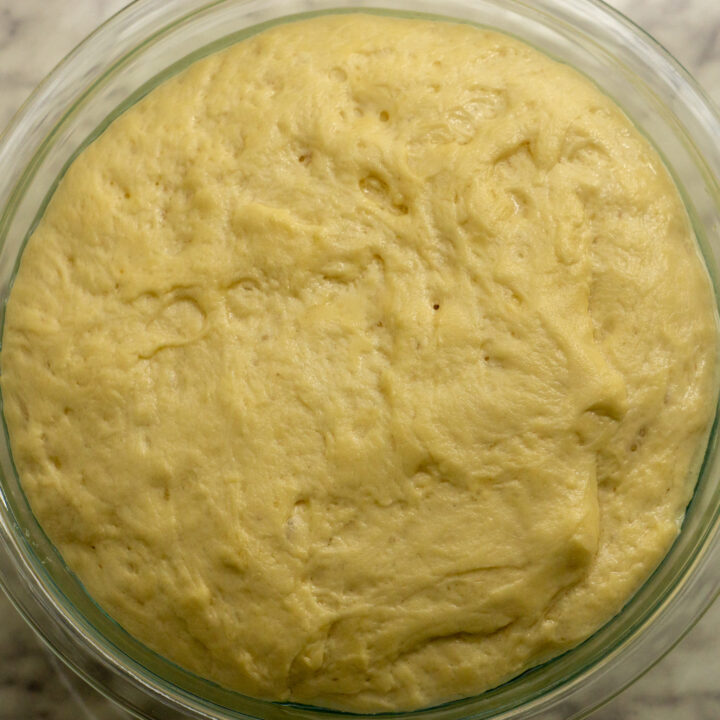
Step 4: Punch down the dough and cut it in half. Place one half back in your greased bowl or bag and the other onto a well floured surface. Use your hands to pat the dough into a rough rectangle, then use a floured rolling pin to roll it ¼ inch thick. Be careful not to roll the dough too thin. Using a pizza slicer or large knife, cut the dough into 2-inch pieces. They don’t have to be perfect, and they don’t even have to be square. You won’t be patting the dough pieces back together, as if you were making cookies or biscuits, so make sure each piece of dough is big enough to fry.
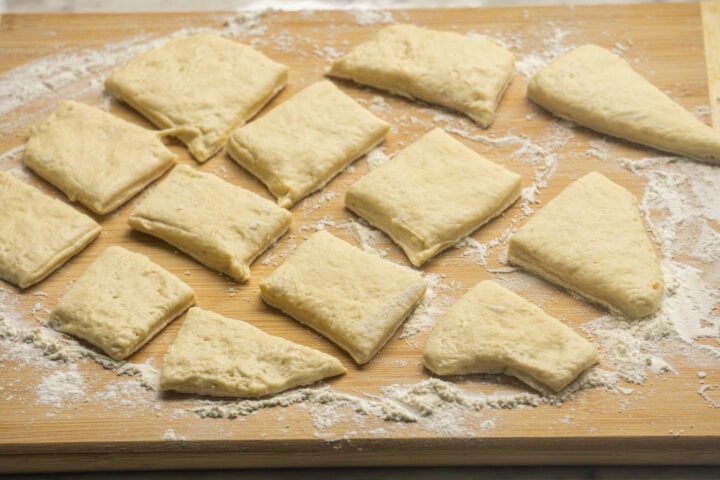
Step 5: Heat 2 inches of vegetable oil in a small saucepan to 370 degrees. (Did I measure this? Absolutely not. I just kept alternating my gas stove between hotter medium and cooler medium to keep my temperature consistent). I used peanut oil, which worked very well, but traditionalists recommend use cottonseed oil. I’d recommend against any oil with a low smoke point, including coconut oil. The oil will be ready when the oil immediately forms bubbles around the piece of dough.
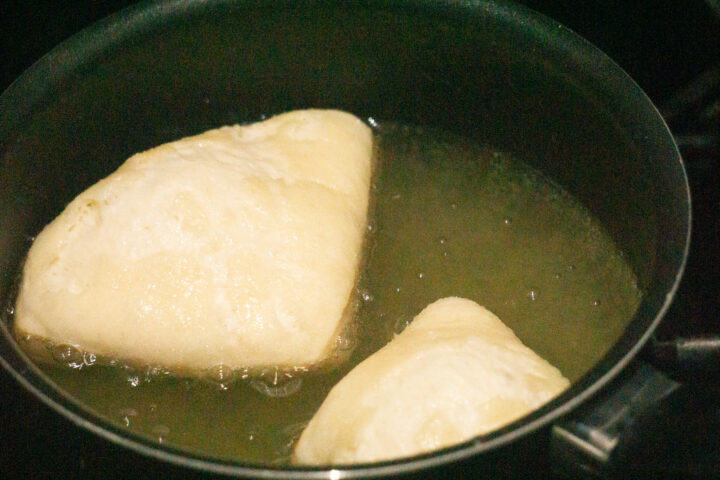
Step 6: Fry each piece of dough in the oil. Don’t add too many pieces of dough at a time. (I used a tiny pot to conserve oil.) I fried each dough ball about two minutes on each side, then an additional minute on the original side. After frying, remove the beignets with a mesh spoon (or, let’s be real, two forks for the normal folks), and place them onto a paper towel to soak up any excess oil. Dust with powdered sugar and serve immediately.
A cautionary note
Since this recipe contains one egg, you kind of have to make the whole thing. And the whole thing makes about 30 beignets. So you might be making–and eating–beignets for a while after this!

How to make the apple compote
Step one: Peel three green apples. Then, slice the apples in half and remove the seeds and stems. After that, dice the apples much as you would an onion, cutting lengthwise then widthwise. (See picture below.)
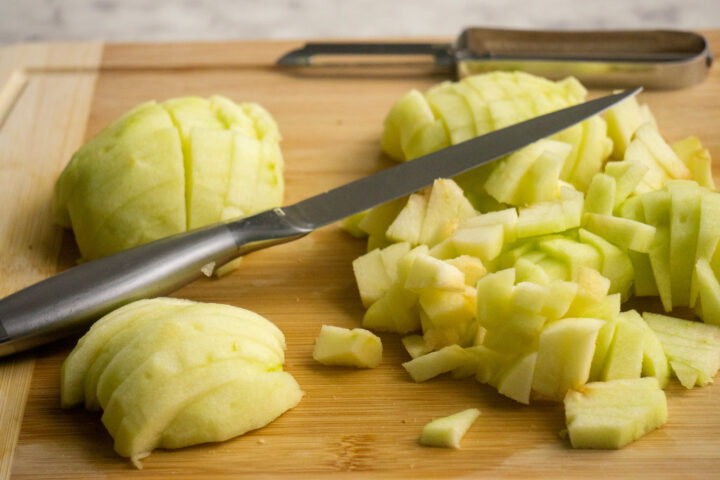
Step 2: Add the apples, 2 tablespoons of water, and two-and-a-half tablespoons sugar to a saucepan and bring them to medium heat. Turn the heat to low and cook covered for 20 minutes. At the end of 20 minutes, add ¾ teaspoon cinnamon, ¼ teaspoon nutmeg, and 1 tablespoon of lemon juice and cook covered for 5 more minutes or until all the apples have softened.
Serve the apple compote warm on the side of the beignets and then scoop the compote into the hole in the middle of the beignet to create your own filling.
Not feeling a sugary, doughy dessert? Try these vegan baked apples instead!

Enjoy!
Print
Beignets with Apple Cinnamon Compote
- Prep Time: 15 minutes
- Cook Time: 30 minutes
- Total Time: 4 hours
- Yield: 30 1x
- Category: desserts
- Method: frying
- Cuisine: New Orleans
- Diet: Vegetarian
Description
A puffy, cloud-like fritter that’s covered in powdered sugar and eaten with spiced apple filling.
Ingredients
For the beignets
- 1 ½ teaspoons active dry yeast*
- ¼ cup sugar
- ¾ cups water (warmed to bathwater temperature)
- ½ cup milk (warmed to bathwater temperature)
- 1 teaspoon vanilla extract*
- 1 egg
- 2 tablespoons melted butter (1–2 tablespoons more if you don’t have whole milk)
- ½ teaspoon kosher salt
- 3 ½ cups all purpose flour
- peanut oil for frying*
- powdered sugar for dusting
For the apple compote
- 3 green apples
- 2 tablespoons water (more as needed)
- 2 ½ tablespoons sugar
- 1 tablespoon lemon juice
- ¾ teaspoon cinnamon
- ¼ teaspoon nutmeg
Instructions
For the beignets
- Heat the water and milk to a warm bathwater temperature (not hot) in a large bowl. Add yeast and 1 tablespoon sugar and let sit for 10 minutes, or until the yeast is all frothy.
- Add the vanilla, melted butter, egg, and 3 more tablespoons sugar to the yeast mixture and whisk until homogenized. Keep whisking as you add the flour in three or four bouts. Keep mixing with a spoon until a shaggy dough forms. It will be something like a biscuit batter.
- Put the dough into a large greased bowl, and roll it around so that the whole thing gets coated in oil. Let the dough sit for three hours, or until it has tripled in size. You can also make the dough in advance and put it in a bag to refrigerate overnight.
- Punch down the dough and cut it in half. Place one half back in your greased bowl or bag and the other onto a well floured surface. Use your hands to pat the dough into a rectangle, then use a floured rolling pin to roll it ¼ inch thick. Using a pizza slicer or large knife, cut the dough into 2-inch pieces.
- Heat 2 inches of peanut oil in a small saucepan to medium. Fry each piece of dough for two minutes on each side, then an additional minute on the original side. After frying, remove the beignets and place them onto a paper towel to soak up any excess oil.
- Dust with powdered sugar and serve immediately with hot coffee or tea and apple compote.
For the apple compote
- Peel the apples, slice them in half, and remove the seeds and stems.
- Dice the apples like you would an onion, cutting lengthwise then widthwise.
- Add the apples, water, and sugar to a saucepan and bring them to medium heat. Turn the heat to low and cook covered for 20 minutes.
- At the end of 20 minutes, add the cinnamon, nutmeg, and lemon juice, and cook covered for five more minutes or until all the apples have softened.
- Serve the apple compote warm with the beignets. Scoop the compote into the hole in the middle of the beignet to create your own filling.
Notes
These recipes were both adapted–quite faithfully–from the New York Times’s recipes. Here’s their recipes for apple compote and for beignets.
If you’re using instant yeast, simply mix all the ingredients together and let rise.
In addition to or instead of vanilla, you could add ¼ teaspoon almond extract for a slightly different flavor. For untraditional beignets, you could even add ¼ teaspoon lemon extract or 1 teaspoon orange blossom water.
Any vegetable oil is just fine, but traditionalists call for cottonseed oil.
Keywords: beignets, fritters, doughnuts, dessert, vegetarian dessert, fried food, holiday food, wheat, pate a choux, pastry, New Orleans, creole cuisine


